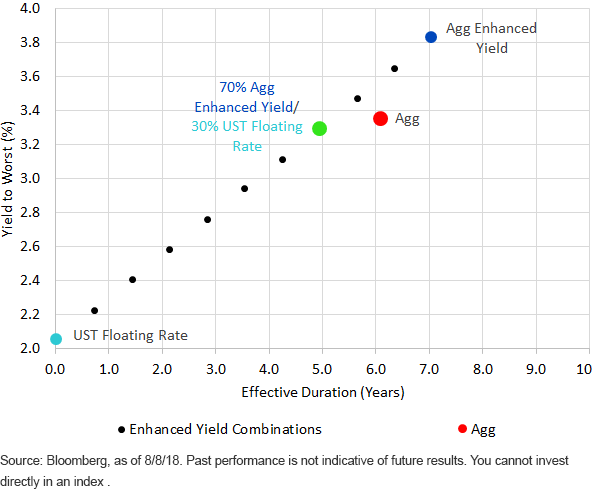WisdomTree launched its first ETFs in June of 2006, pioneering the concept of fundamental weighting. WisdomTree sponsors distinct ETFs that span asset classes and countries around the world.
The Barbell Approach: A Time-Tested Fixed Income Strategy
Although U.S. interest rates have risen from their record-setting depths, there is no doubt that, from a historical basis, they still remain rather low. Against this backdrop, I am asked on a regular basis: What’s a prudent strategy that fixed income investors can follow to not only help mitigate the potential for a further move up in rates but also take income-conscious needs into consideration? A time-tested approach that aims to solve for both of these factors is the barbell strategy.
For those readers who are unfamiliar with such an approach, a fixed income barbell is a strategy that essentially replicates the weight-lifting apparatus. In other words, the investor utilizes two parts of the yield curve : on the one side, the focus will tend to be on an intermediate or longer-duration vehicle while the other end of the spectrum will concentrate on a short-duration instrument. These two “weights” on the barbell serve two different purposes. The intermediate/longer-duration aspect can help to solve for income needs, while the short- duration investment serves as the “rate-mitigating” force.
Yield to Worse and Effective Duration Comparison
Enhanced Yield/UST FRN vs. Aggregate
For definitions of terms in the glossary, please click here .
So, what does the barbell look like in practice? In this blog post, I will focus on two specific indexes: the Bloomberg Barclays U.S. Aggregate Enhanced Yield Index (AEY) and the Bloomberg U.S. Treasury Floating Rate Bond Index (UST FRN) . The latter index, UST FRN, will serve as the short-duration weight of the barbell and is based on the 2-Year Treasury floating rate note . AEY is a yield-enhanced index that reweights the sectors of the Bloomberg Barclays U.S. Aggregate Bond Index (Agg) and serves as the longer-duration weight.
The accompanying graph illustrates how an investor can implement various allocations between these two “weights” of the barbell in order to achieve the desired result. I would like to highlight the combination of 70% AEY and 30% UST FRN. As of this writing, this barbell offers a yield of 3.30%, or only a scant 6 basis points below the Agg, while one could potentially reduce duration by more than a year versus the Agg.
While the Federal Reserve (Fed) kept rates unchanged at last month’s Federal Open Market Meeting, it does appear as if the policy makers are on track to raise the Fed Funds target range at their next gathering on September 26, and perhaps even one more additional time in 2018, finishing the year off at the December 19 convocation with another move to the upside. The Fed’s outlook for 2019 calls for even more rate hikes.
Conclusion
The barbell strategy laid out here offers investors a solution that takes income needs and rate risk into the equation. The WisdomTree Yield Enhanced U.S. Aggregate Bond Fund (AGGY) , which seeks to track the Bloomberg Barclays U.S. Aggregate Enhanced Yield Index, and the WisdomTree Floating Rate Treasury Fund (USFR) , which seeks to track the Bloomberg U.S. Treasury Floating Rate Bond Index , can be utilized as the two “weights” discussed here. Needless to say, the Fed’s monetary policy decisions are a crucial element to the fixed income investment landscape, and given the aforementioned outlook, I’ll continue to revisit this issue in upcoming blog posts.
Unless otherwise noted, all data is from Bloomberg as of August 8, 2018.
RSS Import: Original Source
Investors should carefully consider the investment objectives, risks, charges and expenses of the Funds before investing. U.S. investors only: To obtain a prospectus containing this and other important information, please call 866.909.WISE (9473), or click here to view or download a prospectus online. Read the prospectus carefully before you invest. There are risks involved with investing, including the possible loss of principal. Past performance does not guarantee future results.
You cannot invest directly in an index.
Foreign investing involves currency, political and economic risk. Funds focusing on a single country, sector and/or funds that emphasize investments in smaller companies may experience greater price volatility. Investments in emerging markets, real estate, currency, fixed income and alternative investments include additional risks. Due to the investment strategy of certain Funds, they may make higher capital gain distributions than other ETFs. Please see prospectus for discussion of risks.
WisdomTree Funds are distributed by Foreside Fund Services, LLC, in the U.S. only.



